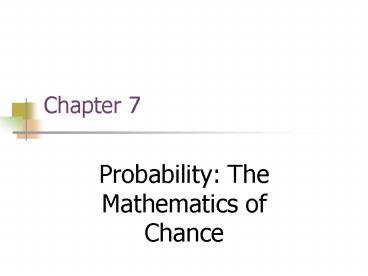Probability: The Mathematics of Chance
1 / 47
Title:
Probability: The Mathematics of Chance
Description:
2: the sum of the probabilities, p(s), for all outcomes, s, in a sample space, S, ... Shape of Normal Curves ... Women's Heights. The 68-95-99.7 Rule ... –
Number of Views:111
Avg rating:3.0/5.0
Title: Probability: The Mathematics of Chance
1
Chapter 7
- Probability The Mathematics of Chance
2
Probability
- Random if the individual outcomes are uncertain,
but the long term behavior is predictable, then
it is called random
3
Probability Theory
- Describes the long term behavior of an action
- Probability the proportion of an outcome in a
very long run of trials of an experiment
4
Flipping A Coin
5
Terminology
- Experiment an activity or phenomenon that is
under consideration - Outcome the results of an experiment
6
Terminology
- Trial one observation of the experiment
- Sample space the set of all possible outcomes
from an experiment
7
More Terminology
- Sample point or simple outcome each element of
the sample space - Event A subset of a sample space
8
Rolling Dice
9
Probability Rules
- 1 every probability, p(s), is a number between
0 and 1 - 2 the sum of the probabilities, p(s), for all
outcomes, s, in a sample space, S, is exactly 1
10
Probability Rules
- 3 if two events have no outcomes in common,
then the probability that one or the other occurs
is the sum of their probabilities
11
Example
- Roll two diceWhat is the probability of rolling
a five?, An even number?, A number greater than
2?, A prime number?
12
Probability Histogram
13
Probability Model
- A probability model is a mathematical description
of an event - It contains a sample space and a manner to assign
probabilities to every event
14
Household Size
- Verify the probability model for the following
data
15
Equally Likely Outcomes
- If a random experiment has k possible outcomes,
all equally likely, then each outcome has a
probability 1/k
16
Equally Likely Outcomes
17
Compound Events
- When in an equally likely experiment, the
probability of an event A is
18
Example
- If you were given a secret code consisting of
three letters, what is the probability of getting
one with no x's?
19
Example
- If the letters cannot repeat, what is the
probability of getting no xs?
20
Counting Rule A
- Suppose you have n things, if you want to arrange
k of then with repetition, then there would be n
? n ? ? ? n nk
21
Counting Rule B
Suppose you have n things, if you want to arrange
k of then without repetition, then there would
be
22
Example
- Seven students are selected to judge a speaking
competition. In how many ways can they be seated
on a stage with seven chairs?
23
Two Games
- Game 1
- 1/10 chance of winning 10,000
- 9/10 chance of winning nothing
- Game 2
- ½ chance of winning 10
- ½ chance of winning nothing
24
Mean of Random Phenomenon
- The mean of a probability model is given by the
following model
25
Household Size
- Find the mean for this probability model
26
Household Size
27
Sum of Two Dice
28
Law of Large Numbers
- Observe any random phenomenon having numerical
outcomes with finite mean ?.Two things will
happen - The proportion of trials on which any outcome
occurs will approach the probability for that
outcome, will approach ?
29
Sampling Distributions
- Sampling variability many samples from the same
population will yield different results - Using histogram to show probability
30
Small Sample Size
31
Large Sample Size
32
Statistics
- A number produced from a sample is a statistic
- Sampling distribution the distribution of values
taken by the statistic in all possible samples
from a population
33
Normal Distributions
- A normal curve assigns probabilities to outcomes
by the measure of area under the curve associated
with a given outcome
34
Normal Distributions
35
1493 Sample Size
36
Shape of Normal Curves
- The mean of a normal distribution lies at the
center of the symmetry of the curve - The standard deviation is located approximately
where the curve changes from down to out
37
Normal Curve
38
Quartiles of a Normal Distribution
- Q1 is located 0.67? below the mean
- Q3 is located 0.67? above the mean
- Remember the median is the mean in a normal
distribution
39
Womens Heights
40
The 68-95-99.7 Rule
- 68 of all observations fall within one standard
deviation of the mean - 95 of all observations fall within two standard
deviation of the mean - 99.7 of all observations fall within three
standard deviation of the mean
41
The 68-95-99.7 Rule
42
Outside the 2nd Deviation
43
The Central Limit Theorem
- A sample mean, or sample proportion from n trials
of an experiment has a distribution that is
approximately normal when n is large
44
The Central Limit Theorem
- The mean of the normal distribution is the same
as a mean of a single trial
45
The Central Limit Theorem
- The standard deviation of the normal distribution
is the standard deviation of a single trial
divided by
46
Casino Example
47
What About Finding the Standard Deviation?
- The standard deviation for a probability model
can be found from the variance































